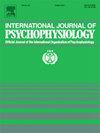Stroop任务中自我参照加工的神经动力学:来自时频和多变量分析的脑电图观察。
IF 2.6
3区 心理学
Q3 NEUROSCIENCES
引用次数: 0
摘要
自我参照信息在冲突加工中具有优势,表现为一致性效应的减弱。尽管通过事件相关电位对这一现象进行了研究,但潜在的神经动力学仍然难以捉摸。此外,注意力资源的调节是特定于自我还是由冲突驱动仍然存在争议。为了阐明这些问题,我们采用脑电图记录了30名参与改良Stroop任务的健康个体的大脑活动。行为结果表明,自我参照信息降低了一致性效应。时间-频率分析表明,与非自我参照条件相比,自我参照条件诱发的事件相关同步(ERS)增加,事件相关非同步(ERD)减少。与一致条件相比,不一致条件诱发的β ERD和β ERS增加。值得注意的是,在不一致条件下,与非自我参照条件相比,自我参照条件诱发的α ERD增加。光谱MVPA结果表明,冲突在θ波段可以成功解码,但在α和β波段不能成功解码。有趣的是,在theta波段解码过程中,自我参照条件下的冲突比非自我参照条件下更早被识别出来。此外,自我参照信息在theta, alpha和beta波段上被成功解码。本文章由计算机程序翻译,如有差异,请以英文原文为准。
The neural dynamics of self-referential processing in Stroop task: EEG insights from time-frequency and multivariate analysis
Self-referential information holds an advantage in conflict processing, manifested as a reduction of the congruency effect. Despite investigations into this phenomenon via event-related potentials, the underlying neuro dynamics remain elusive. Additionally, it remains contentious whether the modulation of attentional resources is specific to the self or driven by conflict. To elucidate these matters, we employed electroencephalography to record the cerebral activity of 30 healthy individuals engaged in a modified Stroop task. The behavioral outcomes demonstrated that self-referential information reduces the congruency effect. Time-frequency analysis revealed that self-reference condition elicited increase theta event-related synchronization (ERS) and decrease event-related desynchronization (ERD) compared to non-self-reference condition. The incongruent condition elicited increase theta ERS and beta ERD compared to congruent condition. Notably, in the incongruent condition, self-reference condition elicited increased alpha ERD compared to the non-self-reference condition. Spectral MVPA results showed that conflict can be successfully decoded in the theta band, but not in the alpha and beta bands. Interestingly, during the theta band decoding, in the self-reference condition, conflicts were identified earlier compared to non-self-reference condition. Furthermore, self-referential information was successfully decoded across the theta, alpha, and beta bands.
求助全文
通过发布文献求助,成功后即可免费获取论文全文。
去求助
来源期刊
CiteScore
5.40
自引率
10.00%
发文量
177
审稿时长
3-8 weeks
期刊介绍:
The International Journal of Psychophysiology is the official journal of the International Organization of Psychophysiology, and provides a respected forum for the publication of high quality original contributions on all aspects of psychophysiology. The journal is interdisciplinary and aims to integrate the neurosciences and behavioral sciences. Empirical, theoretical, and review articles are encouraged in the following areas:
• Cerebral psychophysiology: including functional brain mapping and neuroimaging with Event-Related Potentials (ERPs), Positron Emission Tomography (PET), Functional Magnetic Resonance Imaging (fMRI) and Electroencephalographic studies.
• Autonomic functions: including bilateral electrodermal activity, pupillometry and blood volume changes.
• Cardiovascular Psychophysiology:including studies of blood pressure, cardiac functioning and respiration.
• Somatic psychophysiology: including muscle activity, eye movements and eye blinks.

 求助内容:
求助内容: 应助结果提醒方式:
应助结果提醒方式:


